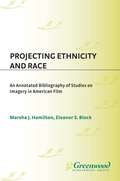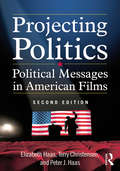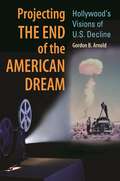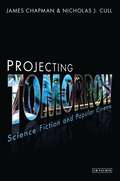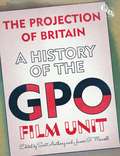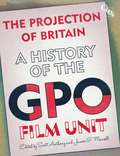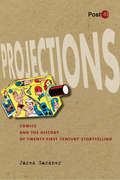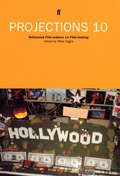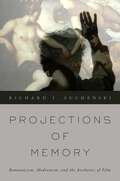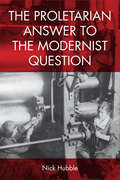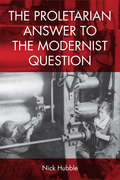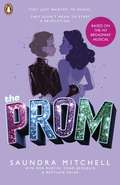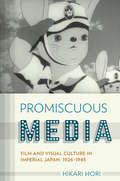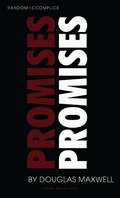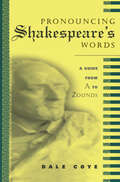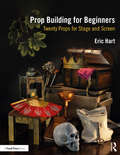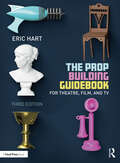- Table View
- List View
Projecting Ethnicity and Race: An Annotated Bibliogaphy of Studies on Imagery in American Film (Bibliographies and Indexes in Ethnic Studies)
by Marsha J. Hamilton Eleanor S. BlockThis comprehensive annotated bibliography reviews nearly 500 English-language studies published between 1915 and 2001 that examine the depiction of ethnic, racial, and national groups as portrayed in United States feature films from the inception of cinema through the present. Coverage includes books, reference works, book chapters within larger works, and individual essays from collections and anthologies. Concise annotations provide content summaries; unique features; major films and filmmakers discussed; and useful information on related titles, purpose, and intended readership. The studies included range from specialized scholarly treatises to popular illustrated books for general readers, making ^IProjecting Ethnicity and Race^R an invaluable resource for researchers interested in ethnic and racial film imagery.Entries are arranged alphabetically by title for easy access, while four separate indexes make the work simple to navigate by author, subject, gender, race, ethnic group, nationality, country, religion, film title, filmmaker, performer, or theme. Although the majority of studies published examine images of African Americans, Hispanic Americans, Native Americans, Asian Americans, and Asians in film, the volume contains studies of groups including Africans, Arabs, the British, Canadians, South Sea Islanders, Tibetans, Buddhists, and Muslims—making it a unique reference book with a wide range of uses for a wide range of scholars.
Projecting Politics: Political Messages in American Films
by Terry Christensen Peter J. Haas Elizabeth HaasThe new edition of this influential work updates and expands the scope of the original, including more sustained analyses of individual films, from The Birth of a Nation to The Wolf of Wall Street. An interdisciplinary exploration of the relationship between American politics and popular films of all kinds—including comedy, science fiction, melodrama, and action-adventure—Projecting Politics offers original approaches to determining the political contours of films, and to connecting cinematic language to political messaging. A new chapter covering 2000 to 2013 updates the decade-by-decade look at the Washington-Hollywood nexus, with special areas of focus including the post-9/11 increase in political films, the rise of political war films, and films about the 2008 economic recession. The new edition also considers recent developments such as the Citizens United Supreme Court decision, the controversy sparked by the film Zero Dark Thirty, newer generation actor-activists, and the effects of shifting industrial financing structures on political content. A new chapter addresses the resurgence of the disaster-apocalyptic film genre with particular attention paid to its themes of political nostalgia and the turn to global settings and audiences. Updated and expanded chapters on nonfiction film and advocacy documentaries, the politics of race and African-American film, and women and gender in political films round out this expansive, timely new work. A companion website offers two additional appendices and further materials for those using the book in class.
Projecting Politics: Political Messages in American Films
by Terry Christensen Peter J. Haas Elizabeth HaasThe new edition of this influential work updates and expands the scope of the original, including more sustained analyses of individual films, from The Birth of a Nation to The Wolf of Wall Street. An interdisciplinary exploration of the relationship between American politics and popular films of all kinds—including comedy, science fiction, melodrama, and action-adventure—Projecting Politics offers original approaches to determining the political contours of films, and to connecting cinematic language to political messaging. A new chapter covering 2000 to 2013 updates the decade-by-decade look at the Washington-Hollywood nexus, with special areas of focus including the post-9/11 increase in political films, the rise of political war films, and films about the 2008 economic recession. The new edition also considers recent developments such as the Citizens United Supreme Court decision, the controversy sparked by the film Zero Dark Thirty, newer generation actor-activists, and the effects of shifting industrial financing structures on political content. A new chapter addresses the resurgence of the disaster-apocalyptic film genre with particular attention paid to its themes of political nostalgia and the turn to global settings and audiences. Updated and expanded chapters on nonfiction film and advocacy documentaries, the politics of race and African-American film, and women and gender in political films round out this expansive, timely new work. A companion website offers two additional appendices and further materials for those using the book in class.
Projecting the End of the American Dream: Hollywood's Visions of U.S. Decline
by Gordon B. ArnoldThis provocative book reveals how Hollywood films reflect our deepest fears and anxieties as a country, often recording our political beliefs and cultural conditions while underscoring the darker side of the American way of life.Long before the war in Iraq and the economic crises of the early 21st century, Hollywood has depicted a grim view of life in the United States, one that belies the prosperity and abundance of the so-called American Dream. While the country emerged from World War II as a world power, collectively our sense of security had been threatened. The result is a cinematic body of work that has America's decline and ruin as a central theme. The author draws from popular films across all genres and six decades to illustrate how the political climate of the times influenced their creation.Projecting the End of the American Dream: Hollywood's Visions of U.S. Decline combines film history, social history, and political history to reveal important themes in the unfolding American narrative. Discussions focus on a wide variety of films, including Rambo, Planet of the Apes, and Easy Rider.
Projecting the End of the American Dream: Hollywood's Visions of U.S. Decline
by Gordon B. ArnoldThis provocative book reveals how Hollywood films reflect our deepest fears and anxieties as a country, often recording our political beliefs and cultural conditions while underscoring the darker side of the American way of life.Long before the war in Iraq and the economic crises of the early 21st century, Hollywood has depicted a grim view of life in the United States, one that belies the prosperity and abundance of the so-called American Dream. While the country emerged from World War II as a world power, collectively our sense of security had been threatened. The result is a cinematic body of work that has America's decline and ruin as a central theme. The author draws from popular films across all genres and six decades to illustrate how the political climate of the times influenced their creation.Projecting the End of the American Dream: Hollywood's Visions of U.S. Decline combines film history, social history, and political history to reveal important themes in the unfolding American narrative. Discussions focus on a wide variety of films, including Rambo, Planet of the Apes, and Easy Rider.
Projecting Tomorrow: Science Fiction and Popular Cinema (Cinema and Society)
by James Chapman Nicholas J. CullCinema and science fiction were made for each other. The science fiction genre has produced some of the most extraordinary films ever made, yet science fiction cinema is about more than just special effects. It has also provided a vehicle for filmmakers and writers to comment on their own societies and cultures. This new exploration of the genre examines landmark science fiction films from the 1930s to the present. They include genre classics such as Things to Come, Forbidden Planet and 2001: A Space Odyssey alongside modern blockbusters Star Wars and Avatar. Chapman and Cull consider both screen originals and adaptations of the work of major science fiction authors. They also range widely across the genre from pulp adventure and space opera to political allegory and speculative documentary – there is even a science fiction musical. Informed throughout by extensive research in US and British archives, the book documents the production histories of each film to show how they made their way to the screen – and why they turned out the way they did.
The Projection of Britain: A History of the GPO Film Unit
by Scott Anthony & James G. MansellThe General Post Office (GPO) Film Unit sat at the creative epicentre of Britain in the 1930s. It nurtured a vital crop of artistic talent, built a forum for a new kind of cinematic address and created Britain's first self-consciously national cinema. In 2011, UNESCO added its work to the UK Memory of the World Register, recognising its status as part of Britain's cultural heritage. Elements of the GPO Film Unit's story are well known: John Grierson's development of documentary cinema; the influence of Mass Observation and Surrealism on its cinematic vision; the Watt–Auden–Britten collaboration Night Mail. The Projection of Britain: A History of the GPO Film Unit brings together primary materials and critical appraisals to revisit, re-contextualise and revitalise these seminal moments in British cinema. Here, the insights of an archivist, a musicologist, a design historian, a sports historian, a geographer and a postman – among others – have been edited into a rich critical archaeology of a compelling moment in cinematic history. Interspersed with these essays are primary materials – memoirs, magazine articles, posters and government documents – that detail everything from Alberto Cavalcanti's vision for the documentary movement to a claim for the clothes Humphrey Jennings lost while shooting on location. In recent years there has been a resurgence of interest in the GPO Film Unit and its work, on the big screen, in DVD boxsets and on the web. The Projection of Britain ties together the Unit's diverse artistic, historical and cultural threads into an essential one-stop resource. Provocative, imaginative and ambitious, this expansive study is the definitive companion to an extraordinary episode in cinematic history.
The Projection of Britain: A History of the GPO Film Unit
The General Post Office (GPO) Film Unit sat at the creative epicentre of Britain in the 1930s. It nurtured a vital crop of artistic talent, built a forum for a new kind of cinematic address and created Britain's first self-consciously national cinema. In 2011, UNESCO added its work to the UK Memory of the World Register, recognising its status as part of Britain's cultural heritage. Elements of the GPO Film Unit's story are well known: John Grierson's development of documentary cinema; the influence of Mass Observation and Surrealism on its cinematic vision; the Watt–Auden–Britten collaboration Night Mail. The Projection of Britain: A History of the GPO Film Unit brings together primary materials and critical appraisals to revisit, re-contextualise and revitalise these seminal moments in British cinema. Here, the insights of an archivist, a musicologist, a design historian, a sports historian, a geographer and a postman – among others – have been edited into a rich critical archaeology of a compelling moment in cinematic history. Interspersed with these essays are primary materials – memoirs, magazine articles, posters and government documents – that detail everything from Alberto Cavalcanti's vision for the documentary movement to a claim for the clothes Humphrey Jennings lost while shooting on location. In recent years there has been a resurgence of interest in the GPO Film Unit and its work, on the big screen, in DVD boxsets and on the web. The Projection of Britain ties together the Unit's diverse artistic, historical and cultural threads into an essential one-stop resource. Provocative, imaginative and ambitious, this expansive study is the definitive companion to an extraordinary episode in cinematic history.
The Projection of Britain: A History of the GPO Film Unit
by James MansellThe General Post Office (GPO) Film Unit sat at the creative epicentre of Britain in the 1930s. It nurtured a vital crop of artistic talent, built a forum for a new kind of cinematic address and created Britain's first self-consciously national cinema. In 2011, UNESCO added its work to the UK Memory of the World Register, recognising its status as part of Britain's cultural heritage. Elements of the GPO Film Unit's story are well known: John Grierson's development of documentary cinema; the influence of Mass Observation and Surrealism on its cinematic vision; the Watt–Auden–Britten collaboration Night Mail. The Projection of Britain: A History of the GPO Film Unit brings together primary materials and critical appraisals to revisit, re-contextualise and revitalise these seminal moments in British cinema. Here, the insights of an archivist, a musicologist, a design historian, a sports historian, a geographer and a postman – among others – have been edited into a rich critical archaeology of a compelling moment in cinematic history. Interspersed with these essays are primary materials – memoirs, magazine articles, posters and government documents – that detail everything from Alberto Cavalcanti's vision for the documentary movement to a claim for the clothes Humphrey Jennings lost while shooting on location. In recent years there has been a resurgence of interest in the GPO Film Unit and its work, on the big screen, in DVD boxsets and on the web. The Projection of Britain ties together the Unit's diverse artistic, historical and cultural threads into an essential one-stop resource. Provocative, imaginative and ambitious, this expansive study is the definitive companion to an extraordinary episode in cinematic history.
Projections: Comics and the History of Twenty-First-Century Storytelling (Post*45 #21)
by Jared GardnerWhen Art Spiegelman's Maus won the Pulitzer Prize in 1992, it marked a new era for comics. Comics are now taken seriously by the same academic and cultural institutions that long dismissed the form. And the visibility of comics continues to increase, with alternative cartoonists now published by major presses and more comics-based films arriving on the screen each year. Projections argues that the seemingly sudden visibility of comics is no accident. Beginning with the parallel development of narrative comics at the turn of the 20th century, comics have long been a form that invites—indeed requires—readers to help shape the stories being told. Today, with the rise of interactive media, the creative techniques and the reading practices comics have been experimenting with for a century are now in universal demand. Recounting the history of comics from the nineteenth-century rise of sequential comics to the newspaper strip, through comic books and underground comix, to the graphic novel and webcomics, Gardner shows why they offer the best models for rethinking storytelling in the twenty-first century. In the process, he reminds us of some beloved characters from our past and present, including Happy Hooligan, Krazy Kat, Crypt Keeper, and Mr. Natural.
Projections 10: Hollywood Film-makers On Film-making
by Mike FiggisMike Figgis has always been intrigued by the workings of the Hollywood System. As he progressed from his acclaimed US debut Internal Affairs, through hellish studio wrangles on Mr. Jones, to Oscar-laurelled success with Leaving Las Vegas, Figgis always wanted to find a way to document the mores of the Hollywood industry, before it could swallow him whole. For Projections, he accepted an invitation to return to LA in late 1998 and create just such a document. In conversation with established players such as Mel Gibson, Jodie Foster and Jerry Bruckheimer, plus ascending talents such as Salma Hayek and Paul Thomas Anderson, Figgis paints a refreshingly honest but unmistakably dark portrait of an industry where money does more than talk.Mike Figgis's witnesses include Mel Gibson, Jodie Foster, Mickey Rourke, Nastassja Kinski, Elizabeth Shue, Salma Hayek, Paul Thomas Anderson, Jerry Bruckheimer and many more . . .
Projections of Memory: Romanticism, Modernism, and the Aesthetics of Film
by Richard I. SuchenskiProjections of Memory is an exploration of a body of innovative cinematic works that utilize their extraordinary scope to construct monuments to the imagination that promise profound transformations of vision, selfhood, and experience. This form of cinema acts as a nexus through which currents from the other arts can interpenetrate. By examining the strategies of these projects in relation to one another and to the larger historical forces that shape them--tracing the shifts and permutations of their forms and aspirations--Projections of Memory remaps film history around some of its most ambitious achievements and helps to clarify the stakes of cinema as a twentieth-century art form.
Projections of Memory: Romanticism, Modernism, and the Aesthetics of Film
by Richard I. SuchenskiProjections of Memory is an exploration of a body of innovative cinematic works that utilize their extraordinary scope to construct monuments to the imagination that promise profound transformations of vision, selfhood, and experience. This form of cinema acts as a nexus through which currents from the other arts can interpenetrate. By examining the strategies of these projects in relation to one another and to the larger historical forces that shape them--tracing the shifts and permutations of their forms and aspirations--Projections of Memory remaps film history around some of its most ambitious achievements and helps to clarify the stakes of cinema as a twentieth-century art form.
The Proletarian Answer to the Modernist Question
by Nick HubbleAnalyses what makes an acting performance excellent, through a range of examples from world cinema
The Proletarian Answer to the Modernist Question
by Nick HubbleWhat do we remember about US Presidents, and how do we come to commemorate their legacies?
The Prom: A Novel Based On The Hit Broadway Musical
by Saundra Mitchell Bob Martin Chad Beguelin Matthew SklarThey just wanted to dance. They didn't mean to start a revolution...The novel of the laugh-out-loud high school musical coming to Netflix in 2020, starring Meryl Streep, James Corden and Nicole Kidman.Emma knows better than anyone that Edgewater, Indiana, is not a great place to be gay. But she's had enough of high school homophobia and really wants to take her girlfriend - the popular, closeted It Girl Alyssa- to prom. How big a deal could that really be? But when their classmates find out, the backlash exceeds Emma's worst nightmares.Meanwhile, in Manhattan, Barry and Dee Dee are Broadway stars of yesteryear. When their new show bombs, they need some good publicity - fast. So when they happen to hear about Emma's plight, they decide to step in and create a prom for everyone.Suddenly, Edgewater is the centre of a national news story. As the drama queens of New York take over the sleepy town, chaos ensues and the glare of the spotlight is brighter than anyone could have guessed.But all Emma and Alyssa want is to dance together. Is that too much to ask?The perfect read for fans of Mean Girls and Dear Evan Hansen!
Promiscuous Media: Film and Visual Culture in Imperial Japan, 1926-1945 (Studies of the Weatherhead East Asian Institute, Columbia University)
by Hikari HoriIn Promiscuous Media, Hikari Hori makes a compelling case that the visual culture of Showa-era Japan articulated urgent issues of modernity rather than serving as a simple expression of nationalism. Hori makes clear that the Japanese cinema of the time was in fact almost wholly built on a foundation of Russian and British film theory as well as American film genres and techniques. Hori provides a range of examples that illustrate how maternal melodrama and animated features, akin to those popularized by Disney, were adopted wholesale by Japanese filmmakers.Emperor Hirohito's image, Hori argues, was inseparable from the development of mass media; he was the first emperor whose public appearances were covered by media ranging from postcards to radio broadcasts. Worship of the emperor through viewing his image, Hori shows, taught the Japanese people how to look at images and primed their enjoyment of early animation and documentary films alike. Promiscuous Media links the political and the cultural closely in a way that illuminates the nature of twentieth-century Japanese society.
Promised Lands: Cinema, Geography, Modernism
by Sam RohdieAn attempt to locate cinema alongside philosophy, painting, geography and travel in terms of a history of modernism. The book focuses on a collection of geographical and ethnographic films and photographs amassed by banker Albert Kahn, in the 1900s - arguably an instance of French modernism.
Promised Lands: Cinema, Geography, Modernism
by Sam RohdieAn attempt to locate cinema alongside philosophy, painting, geography and travel in terms of a history of modernism. The book focuses on a collection of geographical and ethnographic films and photographs amassed by banker Albert Kahn, in the 1900s - arguably an instance of French modernism.
Promises Promises (Oberon Modern Plays Ser.)
by Douglas MaxwellGiven her disreputable past, retired teacher Maggie Brodie knows she was a last minute choice for supply cover. Being patronised by the idiotic young headmaster is an indignity she can just about endure. But her frustrations increase when a silent Somalian child in her class, whom Maggie is inexplicably drawn to, is believed by her family and community to be possessed. Maggie seems to be the only one who is outraged and protective of the girl. And if they don’t listen to her, she will be forced to take action. Drastic action.
Pronouncing Shakespeare's Words
by Dale CoyeFirst published in 2003. Routledge is an imprint of Taylor & Francis, an informa company.
Pronouncing Shakespeare's Words: A Guide From A To Zounds
by Dale CoyeFirst published in 2003. Routledge is an imprint of Taylor & Francis, an informa company.
Prop Building for Beginners: Twenty Props for Stage and Screen
by Eric HartProp Building for Beginners outlines the basic concepts of prop building by featuring step-by-step instructions to create twenty of the most commonly featured items in theatrical and filmed productions. This book uses a combination of projects to expose readers to a wide range of materials and tools that they might find in a basic scenery or costume shop, serving both as a guide to building simple props and as a crash course in the variety of items a props person may have to build. The projects require a variety of tools, techniques, and materials so that a practitioner who completes all of them will have received a complete introduction to the basics of prop building. Assuming no previous knowledge of prop building, this is the perfect primer for students, hobbyists, or community theater enthusiasts looking to enter the prop shop. Prop Building for Beginners includes access to full-scale printable versions of the patterns featured in the book.
The Prop Building Guidebook: For Theatre, Film, and TV
by Eric HartNow in its third edition, The Prop Building Guidebook: For Theatre, Film, and TV walks readers through techniques used in historical and contemporary prop making and demonstrates how to apply them to a variety of materials. Experienced prop maker Eric Hart covers the tools and techniques used by professional prop makers throughout the entertainment industry. He outlines a construction process that gives readers the foundational knowledge to choose the best materials and methods for each prop and the background information to know the advantages of these choices. This new edition includes updated information and techniques throughout, including: Over a hundred new images and diagrams Updated terminology, products, and brands used internationally Expanded sections on 3D printing, vacuum forming, foam patterning, and more A new chapter on prop design New information on international safety standards, cleaning, and sanitation More recipes and step-by-step instruction for various finishes Illustrated by hundreds of full-color photographs, this is the most comprehensive guide to prop construction available for professional and student prop makers in theatre, film, and tv. For additional how-to videos, instructional documents, and supplemental information, visit www.propbuildingguidebook.com.
The Prop Building Guidebook: For Theatre, Film, and TV
by Eric HartNow in its third edition, The Prop Building Guidebook: For Theatre, Film, and TV walks readers through techniques used in historical and contemporary prop making and demonstrates how to apply them to a variety of materials. Experienced prop maker Eric Hart covers the tools and techniques used by professional prop makers throughout the entertainment industry. He outlines a construction process that gives readers the foundational knowledge to choose the best materials and methods for each prop and the background information to know the advantages of these choices. This new edition includes updated information and techniques throughout, including: Over a hundred new images and diagrams Updated terminology, products, and brands used internationally Expanded sections on 3D printing, vacuum forming, foam patterning, and more A new chapter on prop design New information on international safety standards, cleaning, and sanitation More recipes and step-by-step instruction for various finishes Illustrated by hundreds of full-color photographs, this is the most comprehensive guide to prop construction available for professional and student prop makers in theatre, film, and tv. For additional how-to videos, instructional documents, and supplemental information, visit www.propbuildingguidebook.com.
